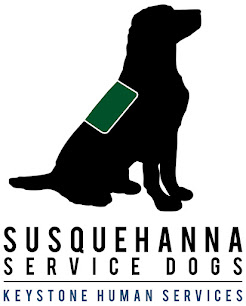"Rossi, puppy in a box." At those words, SSD Rossi puts one, two, three, all four feet inside an empty half-gallon ice cream container. Pretty neat trick, isn't it?
While puppy-in-a-box might not be a typical service dog skill, the method used to teach it is an important part of our service dogs' training. Rossi's handlers used shaping to train her to put all four feet in an ice cream carton.
When you're shaping a behavior, you're reinforcing small steps toward the behavior until you achieve the actual behavior. For example, to shape puppy-in-a-box, you would start by clicking your dog for looking at the box, then build up to touching the box with his nose, touching it with a paw, putting a paw in the box, putting two feet in the box, etc.
We generally don't talk or communicate with the dog while we're shaping a behavior. We want the dog to experiment, move around and offer different behaviors. When the dog gives a behavior that is a step toward the final behavior we're looking for, we click and treat. Often, we'll toss the treat away from the dog to reset him, so that he has to move around and offer a slightly different behavior.
When the dog is giving a behavior 80% of the time, we'll raise our standards for which behaviors get clicks. For example, instead of clicking for touching the box with a paw, we'll wait for the dog to leave his paw in the box for a few seconds, then click and treat.
We took video of Rossi demonstrating shaping at one of our puppy classes. Her handler wanted her to pick up a piece of garden hose and place it on the wooden podium. To train her to do that, he clicked and treated her for small steps along the way - looking at the hose, picking it up, walking with it, walking toward the podium and finally, putting the hose on the podium. Notice how he keeps raising his standards, making Rossi experiment until she finds a behavior that gets her a click. Also note that when Rossi seems stuck, her handler moves around to both reset her and give her hints about what he wants her to do.
Mary Hunter, a clicker trainer and blogger, has a very nice video on her Stale Cheerios blog that illustrates shaping. You can see how the dog continually experiments with behaviors until he discovers the one that earns him a click and treat.
As we refine a behavior, we add the verbal cue just before the behavior is given. Over time, we will only click for behaviors that we specifically asked for using the verbal cue.
Shaping is a very positive method of training dogs (and almost any animal), and we use it in our service dog training. It teaches the dogs to experiment with different behaviors, and it's fun for both our service dogs-in-training and our trainers and puppy raisers.
Thursday, January 7, 2010
Subscribe to:
Post Comments (Atom)









I loved your video of Rossi.
ReplyDeleteGinger and I have been working on training behaviors using just shaping. She is getting a lot better than she was, but it still takes time.
What I think I liked most about the Rossi video is how it looked like they were working as a team. The dog and handler both seemed experienced with shaping and learning new tasks, and because of this, the handler was able to quickly teach the dog what to do. The whole sequence looked very smooth, and there was no sign of frustration on the part of the dog. I am continually in awe of service dogs, both for their intelligence and the level they are expected to perform at!
cheers,
Mary
(P.S. thanks for linking to my site!)